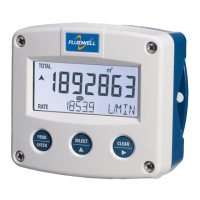FW_F115-P_M_v2201-01_EN.docx
A low flow cut-off, e.g. to ignore leakage, can be set as a percentage of the
full range of 16 mA, 20 mA or 10 V.
When the flow is less than the required rate, the current will be the
minimum signal (4 mA, 0 mA, 0 V). Example:
(800-20)*3.5%= 27.3 L/min
The (0)4 mA or 0 V value can be tuned precisely with this setting. The
initial minimum analog output value is (0) 4mA or 0 V. However, this value
might differ slightly due to ambient influences such as temperature for
example.
Before tuning the signal, make sure that the analog signal is idle (not
used) for any application!
After pressing PROG, the current will be about 4 mA (0 mA or 0 V). The
current can be increased / decreased with the arrow keys and is directly
active. Press ENTER to store the new value.
If required, you can program the analog output 'up-side-down'. The (0)4
mA or 0 V represents the maximum flow rate and the 20 mA or 10 V
represents the minimum flow rate.
The 20 mA or 10 V value can be tuned precisely with this setting. The initial
maximum analog output value is 20 mA or 10 V However, this value might
differ slightly due to ambient influences such as temperature for example.
Before tuning the signal, make sure that the analog signal is idle (not
used) for any application!
After pressing PROG, the current will be about 20 mA or 10 V. The current
can be increased / decreased with the arrow keys and is directly active.
Press ENTER to store the new value.
If required, you can program the analog output 'up-side-down'. The (0)4
mA or 0 V represents the maximum flow rate and the 20 mA or 10 V
represents the minimum flow rate.
This setting is used to stabilize the output signal. With the help of this
digital filter a more stable but less actual representation of the flow rate can
be obtained.
The filter principal is based on three input values: the filter level (01-99),
the last calculated flow rate and the last average value. The higher the filter
level, the longer the response time on a value change will be.
RESPONSE TIME ON STEP CHANGE OF ANALOG VALUE (% OF END VALUE)

